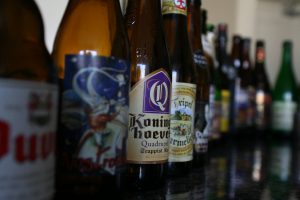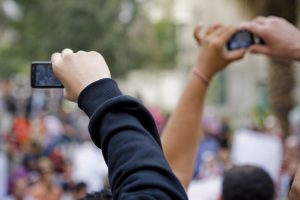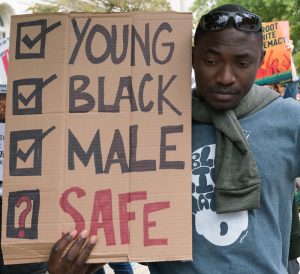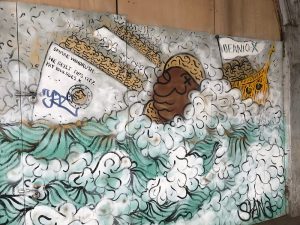Verbal hygiene

Clean and pure (photo credit: badjonni CC BY-NC-SA 2.0)
Verbal hygiene is a term used by Deborah Cameron in her 1995 book to refer to people’s intentional attempts to criticise, regulate and correct other people’s linguistic performances. In Cameron’s words, it’s the ‘discourses and practices through which people attempt to “clean up” language and make its structure or its use conform more closely to their ideals of beauty, truth, efficiency, logic, correctness and civility’ (Cameron, 1995, p. vii). Verbal hygiene is a common phenomenon which often involves a traditionalist army of grammarians, plain language enthusiasts, or keepers of ‘correct’ usage, who feel that language change is undesirable, and, if it does happen, leads to cultural chaos.
Acts of verbal hygiene often include correcting peoples’ ‘deviant’ or ‘incorrect’ language forms like when someone says, ‘I don’t know who I’ll go to the prom with’ instead of ‘I don’t know with whom I’ll go to the prom’. Or ‘Me and Samantha had lunch’ instead of ‘Samantha and I had lunch’. Both examples here involve grammatical features. Pronunciation is another aspect that often attracts people’s attention. Remember in Chapter 7, we talked about the case of Hayley, a Love Island contestant who was criticised for her Liverpudlian accent. Another example of verbal hygiene is telling people to use politically correct or euphemistic language such as ‘physically challenged’ instead of ‘disabled’, or telling people not to use swear words because these forms of language are considered by some to be ‘impolite’ or ‘inappropriate’.
According to Cameron, acts of verbal hygiene can have different political and social functions. They can, for example, be symbolic expressions of people’s anxieties about social change. Consider for instance how communication changed due to the rapid development of digital media and how novel and creative ways of writing started to be used online, especially by members of the younger generation. The emergence of linguistic features like ‘LOL’, ‘OMG’ and so on, caused moral panic among some people who consider them ‘incorrect’ forms which damage language.
Language ‘policing’ practices are also tools through which people can negotiate their status and power. In superdiverse communities for instance many people creatively mix different codes from their linguistic repertoire, resulting in hybrid forms. This practice might be considered ‘bad’ by some who might describe those engaged with language mixing as uneducated or unsuitable for certain kinds of jobs. Verbal hygiene provides not only a direct way to impose the standard and argue against any form of deviance but also as an indirect way to talk about other things like race, age and morality.
Consequently, this practice can be used to demarcate boundaries between groups, separating ‘us’ from ‘them’; namely ‘us’: the protectors of language who want to ensure its purity, correctness and authenticity versus ‘them’: those who damage, distort, and spoil the language. At the same time Cameron explains that these practices can also create in-group solidarity among those who participate in them.
References
Cameron, D. (1995). Verbal hygiene. London: Routledge.
https://www.babbel.com/en/magazine/verbal-hygiene
https://www.futurelearn.com/info/courses/multilingual/0/steps/12513
Orders of Indexicality

Created by Libby Levi for opensource.com (CC BY-SA 2.0)
In Chapter 2 we talk a lot about ‘indexical meaning’, the kind of meaning that comes not from the ‘dictionary’ meaning of words but from the social meaning of the resources (such as languages, registers, styles, gestures, clothing) that we use in communication and how we use them. Indexical meaning usually ‘points to’ societal ideas about particular kinds of people, particular kinds of activities, and particular kinds of attitudes. Because of this, we can say that indexical meaning is always somehow imbued with value since all societies value different kinds of people, different kinds of activities and different kinds of attitudes differently.
This is where the idea of ‘orders of indexicality’ comes in. The term comes from the work of Jan Blommaert (2007), but it traces its roots to another famous linguist, Michael Silverstein (2003). Indexical meaning, Silverstein argued, is not unstructured, but patterned, so that clusters of language forms tend to work together to invoke certain social identities. Silverstein also talked about how indexical meaning works on different ‘levels’ or, as he put it, ‘indexical orders’. At its most basic level (what Silverstein calls ‘first order indexicality’), a language form ‘points to’ a particular person place or thing in the physical environment. A particular way of speaking, for instance, may mark someone as being from a particular place. In ‘second order indexicality’, the fact of a particular language form being linked to the physical world in some way starts to get mixed up with existing ideas about certain types of people, places and things. This way of speaking, for instance, which originally just indexed being from a particular place starts to get mixed up with ideas about what people from this particular place are like. Finally, ‘third order indexicality’ links these types of people, places and things to social values, ideas, for example, about whether the people who speak this way are ‘good’, ‘hardworking’ and ‘moral’ or ‘bad’, ‘lazy’ and ‘dissolute’.
Blommaert (2010) notes that these indexical orders often take a long time to develop, and their histories are sometimes deeply embedded in histories of nations, regions, or classes. As such, they usually end up being supported by various mythologies or ideologies that grow up within these nations, regions or classes such as the ‘standard language ideology’ or notions of ‘national identity’. The most important thing about these indexical orders, however, is that they produce ‘social categories, recognizable semiotic emblems for groups and individuals, a more or less coherent semiotic habitat’ (Blommaert, 2010: 38).
In formulating his idea of orders of indexicality, Blommaert focuses on what Sliverstein called ‘third order indexicality’, noting that indexical orders almost always end up being stratified, with different language forms (or other semiotic resources) being arranged in hierarchies of value – higher/lower, better/worse. These hierarchies of value themselves become forms of social structuring and means by which certain people exert power over other people. Systematic patterns of indexicality, then, to use Blommaert’s words (2007:38), are also ‘systematic patterns of authority, of control and evaluation, and hence of inclusion and exclusion.’
References
Blommaert, J. (2007). Sociolinguistics and Discourse Analysis: Orders of Indexicality and Polycentricity. Journal of Multicultural Discourses, 2(2), 115–130.
Blommaert, J. (2010) The sociolinguistics of globalization, Cambridge: Cambridge University Press.
Silverstein, M. (2003). Indexical order and the dialectics of sociolinguistic life. Language & Communication, 23(3–4).
Brutoglossia: The enregisterment of connoisseurship in craft beer talk

“beer” by hadsie is licensed under CC BY-NC-SA 2.0
In Chapter 3 we talked about the work of Barbara Johnstone on the ‘enregisterment’ of Pittsburgese. Enregisterment is the process whereby linguistic features or more generally a linguistic repertoire comes to be culturally associated with particular social practices and persons who engage in those practices (see also Agha, 2003).
Enregisterment is a useful concept for studying language variation, not only in relation to regional varieties but also in relation to other kinds of registers and genres. Silverstein (2003, 2016) for instance used the idea of enregisterment to study a specific register called oinoglossia or ‘wine talk’. He argued that the use of specialised wine terminology and the ritual of ‘tasting’ develops a particular discursive genre the use of which ‘distinguishes professional and serious avocational tasters from all others’ (2003:223).
Building on Silverstein’s work, Lex Konnelly (2020) explored the enregisterment of ‘brutoglossia’ – a specific register that corresponds to the way craft beer consumers talk about beer. He presents an analysis of a small sample of craft beer from Toronto, Canada. The two brands under investigation were Great Lakes and Burdock and they were chosen because they were considered the ‘most popular’ by a local culture website in Toronto. Konnelly analysed the craft beers’ websits, focusing on (a) the descriptions of the breweries and brewers themselves, and (b) the descriptions of the first three beers available on their website.
He conducted a close analysis of lexical items as well as morphosyntax features. For his lexical analysis, he used the beer ‘flavour wheel’; this is the first system of flavour terminology developed in the 1970s to identify, define, and communicate beer attributes (Garneau & Barr, 2016). Aspects such as taste, aroma, and mouthfeel, were taken into consideration along with recognisable flavours such as sulphuric, fruity, and dry. Konnelly explains that this analysis enabled him to unveil each brewery’s beer lingo and philosophy.
He found that the appropriation of wine terminology and tasting practices (re)configures beer brewers and drinkers as ‘elite’ and ‘classy’. Also, the juxtaposition with less fancy things like winter hats and yard work (re)configures a historically working-class beverage, and its brewers and drinkers as a commodity for elite consumption. Through this analysis, it also became evident that craft beer is becoming an increasingly important part of an emergent ‘hipster,’ ‘yuppie’ lifestyle, where authenticity and locality are key selling points.
References
Agha, A. (2003). The social life of cultural value. Lang. Commun. 23, 231–273.
Garneau, N. & Barr, L. (2016). The beer flavor map: A new tool for bringing modern science to flavor analysis. Paper Presented at the 2016 World Brewing Congress. Denver, Colorado.
Konnelly, L. (2020). Brutoglossia: Democracy, authenticity, and the enregisterment of connoisseurship in ‘craft beer talk’. Language & Communication, 75, 69-82.
Silverstein, M. (2003). Indexical order and the dialectics of sociolinguistic life. Lang. Commun. 23, 193–229.
Silverstein, M. (2016). Semiotic vinification and the scaling of taste. In E., Summerson Carr & M. Lempert (Eds.), Discourse and dimensions of social life (pp. 185–212). Berkley: University of California Press.
Media Sociolinguistics

Floodlights in a TV Studio: Image credit: Picturepest (CC BY 2.0)
According to the media studies scholar Sonia Livingstone (2009), we are currently living in societies in which nearly ‘everything is mediated’ and little can be understood without talking media into account. It is not surprising, therefore, that many sociolinguists over the years have been interested in the way media, from television to the internet, affect how people use language and how ideas about language use are spread (Androutsopoulos, 2014a; Bell, 1995). Media also play a role in making communicative resources other than language (such as images and music) more prominent. Sociolinguists who are interested in media are sometimes called ‘media sociolinguists’.
Some media sociolinguists are interested in how media affect language variation and change (see Chapters 3 and 9). This might mean examining how media consumption of exposure acts as an independent variable in people’s adoption of particular linguistic variants, the role of media in promoting or stigmatizing certain ways of speaking, or their role in spreading particular linguistic innovations across geographical distances (such as the diffusion of the quotative ‘like’ from southern California to the rest of the English-speaking world). There has also been interest in how mass media can affect minority languages, either helping to preserve them or contributing to their demise. Media sociolinguists have also focused on the ways people actively draw on their media experiences to ‘assemble inventories of media voices whose composition indexes the lifestyle and media consumption of a particular community or group’ (Androutsopoulos, 2014, p. 20).
Other media sociolinguists are interested in how media affect how people interact and the ways they adapt their language use for different audiences. In fact, one of the most famous media linguists is Alan Bell, who, apart from doing extensive research on news discourse (1991), also came up with the notion of linguistic style as ‘audience design’ (1984, see Chapter 6) based on his studies of the way radio announcers in New Zealand talked. Several sociolinguists have adapted Bell’s ideas to examining the ‘participation frameworks’ of media interaction. This is especially relevant to studies of interaction through digital media such as those conducted by scholars like Jannis Androutsopoulos (2014b) and Caroline Tagg and Phillip Seargeant (Tagg et al. 2017).
Finally, scholars of language and media have focused on the role of media representations in promoting certain language ideologies and media ideologies and shaping language attitudes. Such studies sometime examine how certain ways of talking are ‘stylized’ in media products such as television shows and popular music and used to index certain kinds of social identities. One of the most famous studies of this sort is Rosina Lippi-Green’s exploration of the use of different accents in Disney films. Others are interested in the way media serve as a site for metalinguistic discourse – people talking and debating about language. The study by Aslan and Vasquez (2018) featured in Chapter 3 is an example of such a study. According to Milani and Johnson (2010, p. 4), ‘the power of the media in language ideological processes lies to a considerable extent in their practices as gatekeepers… on language related issues.’
References
Androutsopoulos, J. (2014a). Mediatization and sociolinguistic change: Key concepts, research traditions, open issues. In J. Androutsopoulos (Ed.), Mediatization and Sociolinguistic Change (pp. 3-48). Berlin, Boston: De Gruyter. https://doi.org/10.1515/9783110346831.3
Androutsopoulos, J. (2014b). Languaging when contexts collapse: Audience design in social networking. Discourse, Context & Media, 4–5, 62–73. https://doi.org/10.1016/j.dcm.2014.08.006
Aslan, E., & Vásquez, C. (2018). ‘Cash me ousside’: A citizen sociolinguistic analysis of online metalinguistic commentary. Journal of Sociolinguistics, 22(4), 406–431. https://doi.org/10.1111/josl.12303
Bell, A. (1984). Language style as audience design. Language in Society, 13, 145–204.
Bell, A. (1991). The Language of news media. Oxford: Blackwell.
Bell, A. (1995). Language and the media. Annual Review of Applied Linguistics, 15, 23–41. https://doi.org/10.1017/S0267190500002592
Lippi-Green, R. (2012). English with an accent: Language, ideology and discrimination in the United States (2nd ed). London ; New York: Routledge.
Livingstone, S. (2009). On the mediation of everything. Journal of Communication, 59 (1),
1–18.
Tagg, C., Seargeant, P., & Brown, A. A. (2017). Taking offence on social media: Conviviality and communication on Facebook (1st ed. 2017 edition). New York, NY: Palgrave Macmillan.
Digital translanguaging in EFL classes

“Study hard” by bartosz.maciejewski is licensed under CC BY-SA 2.0
Consider this quote from Dumrukcic (2020:110): ‘Picture a classroom full of students where the class is about to begin. Two students are deeply immersed in conversation using language X, until another person shows them a video posted on Facebook in language Y, and they leave comments in languages X and Y. A student sits in the corner listening to music in language Z but is writing a post on their Twitter page in languages X and Y. The teacher comes in, greets the students in language X and asks them to settle down, but once the class begins, she uses language Y. She asks the students to read the text written in language Y and discuss it among themselves. Many students choose language X, others choose to discuss it in language Y, others still use features from both within the same conversation. They report back to the teacher in language Y, while one student says a word in language X because she cannot remember it in language Y. This is a situation that frequently occurred in the International Baccalaureate Diploma Programme at Druga Gimnazija Sarajevo while I was a student there from 2008-2010.’
This is an example of multilingual practices taking place in an international school classroom. Since the concept of translanguaging originated in the domain of education, many sociolinguists have applied this theory to explore educational spaces similar to the one discussed above. But as we can see from this example, communicative practices in the classroom do not only involve communication around learning; they also involve other kinds of communicative practices beyond the lesson. It is not uncommon to find instances of different resources being used on social media platforms; this has led some scholars to turn their focus to online translanguaging spaces.
Digital writing on social networking sites is interesting to explore because writing in these digital spaces is highly creative and characterised by a rich mix of linguistic and semiotic modes. In a study conducted in 2015, Schreiber examined the digital writing practices of one Serbian university student who used multiple linguistic codes and semiotic resources on Facebook. Schreiber argues that such practices create important spaces for second language play, development, and identity work.
Aleksandar, the student under investigation, was a hip-hop artist. After examining his Facebook posts, Schreiber noticed that he mixed linguistic codes like English and Serbian freely and appropriated hip-hop codes, drawing upon his full linguistic repertoire. He also exploited the multimodal affordances of Facebook to post images and embed music video links in his posts. All these practices enabled him to shape his online identity and establish himself as a distinctly Serbian member of the global hip-hop community.
Schreiber points out that Aleksandar’s language practices are translingual (Canagarajah, 2011) because he integrates an array of linguistic and semiotic resources to achieve his communicative goals. Schreiber also observes that unfortunately these sophisticated textual practices are undervalued in his EFL classes, where formal, monolingual, non-digital literacy is expected. These findings suggest a need to re-evaluate and expand the focus of EFL writing pedagogy.
References
Canagarajah, A. S. (2011). Codemeshing in academic writing: Identifying teachable strategies of translanguaging. The Modern Language Journal, 95(3), 401–417.
Dumrukcic, N. (2020). Translanguaging in social media. Output for FLT didactics. heiEDUCATION Journal, 5, 109–137.
Schreiber, B.R. (2015). “I am what I am”: Multilingual identity and digital translanguaging. Language Learning & Technology, 19(3), 69–87.
The ‘auditor effect’ and digital media

Video recording with mobile phones (photo credit: Hossam el-Hamalawy, CC BY 2.0)
In Chapter 6 we talked briefly about the effect of digital media on audience design and style. We discussed, for example, the work of media sociolinguist Jannis Androutsopoulos (2014) on how people on Facebook with very diverse social networks consisting of people from different countries alter the language of their posts based on who they want to include in their messages. We also talked about media scholar danah boyd’s (2012) studies of teenagers using Twitter, in which she found that they sometimes alter the style or content of messages intended for their friends in order to hide their meanings from their parents, and also how they sometime compose messages to intentionally make people for whom they are not intended feel excluded. These studies reveal how the new participation structures made possible by social media can complicate the choices people make when they try to design their communication to fit certain audiences.
As we said in Chapter 6, the effect that listeners other than the intended addressee has on a speaker’s speech is known as the auditor effect. Bell (1984) talks about three kinds of listeners other than addressees: auditors (people who are part of our conversation but whom we are not addressing directly), overhearers (people who are not part of our conversation but can overhear what we are saying), and eavesdroppers (people who are secretly listening in on our conversation). As we said in Chapter 6, sociolinguists have extensively studied the effect of auditors on people’s stylistic choices. But there has been much less attention to the effects of overhearers and eavesdroppers, the assumption being that, since we are usually less aware of them, they don’t have much effect the choices we make about style.
In digital environments, however, there is generally much more awareness that certain people (or certain kinds of people) might be listening in, and this might affect the way we design our messages (Jones, 2018). One of the biggest differences between social media communication and most face-to-face communication is that on social media you are never quite sure who might see the content that you post. It might, for example, be seen by people in your social network whom you are not intending to see it, or even people outside your network, who might see it because someone in your network shared it, maybe without you knowing. There are also, all sorts of ‘eavesdroppers’ online – someone might, for example, ‘stalk’ your social media accounts without you knowing about it, or someone might hack into your account. There is also the fact that, whenever we use social media platforms, the companies that own those platforms are constantly gathering data about what we post and how we react to other people’s posts in order to serve us content (including advertisements) that they think we will be interested in. The knowledge that people other than our intended addressees might be monitoring our posts can affect the choices we make about style or content, or even whether we choose to send a particular post at all. Even the knowledge that our online behaviour is being audited by non-human agents such as algorithms can alter the way we behave. Jones (2021a), for example, found that people’s ideas about how the algorithms that social media platforms use to personalise content monitor their behaviour had an effect on the ways they communicated online.
But digital media have also dramatically changed the way the auditor effect works in face-to-face communication as well. One way is the ability that people have to use their mobile phones to audit their interactions with others. They might, for example, use their phones to video record the behaviour of someone who they think is behaving badly in public and then post that video on a social media platform, or they might video record an encounter with a police officer or other authority figure in order to document it or in the hopes that the presence of the video camera might serve the make the officer more accountable for his or her actions.
In a study of videos recorded by drivers who were stopped by the police, Jones (2021b, c) points out how the presence of a video camera can change the way both police and drivers act and talk. The presence of this ‘electronic auditor’, for instance, might make participants more accommodating to each other, but it also has the potential to make them less accommodating and more confrontational. One of the most important observations that Jones makes is that, through the ways they hold or point their mobile phones, people have the ability to design them as different kinds of ‘listeners’ (such as auditors, overhearers, eavesdroppers, or even as addressees), and the different ways the camera is positioned as a ‘listener’ in the interaction can have different effects on the way people talk.
References
Androutsopoulos, J. (2014). Languaging when contexts collapse: Audience design in social networking. Discourse, Context & Media, 4–5, 62–73.
Bell, A. (1984). Language style as audience design. Language in Society, 13, 145–204.
boyd, d. (2012). Networked privacy: How teenagers negotiate context in social media. Surveillance & Society, 10(3/4), 348–50.
Jones, R. H. (2018). Auditor design and digital surveillance, A talk given at SOAS University of London, January 23. Available at https://www.youtube.com/watch?v=6yDWlAYKJiM
Jones, R.H. (2021a). The text is reading you: Teaching language in the age of the algorithm. Linguistics and Education 62, 100750. https://doi.org/10.1016/j.linged.2019.100750
Jones, R.H. (2021b). Auditor design and accountability in encounters between citizens and police. In C. Charalambous & E. McCluskey (eds.) Security, ethnography and discourse: Transdisciplinary encounters (pp. 170-198). Abington, Oxon: Routledge.
Jones, R.H. (2021c). Visibility and accountability in citizens’ encounters with police: An applied linguistic perspective. A talk given at the Open DiscourseNet Seminar, London, November 26. Available at https://www.youtube.com/watch?v=NqGpWk5OyP4
Raciolinguistics

March for racial justice (photo credit: Victoria Pickering, CC,BY 2.0)
The debates about language attitudes, mocking and appropriation that we discussed in Chapter 7 highlight how people’s ideas about language are intimately tied up with their ideas about race and ethnicity. The attitudes that people have about certain ways of using language are often rooted in deep seated attitudes about the racial or ethnic groups associated with these ways of talking. People often have expectations about the way others will or should speak based on their physical appearance, or expectations about their appearance based on the way they speak. Language mocking often reproduces racial or ethnic stereotypes, and the ways people appropriate the linguistic resources associated with other racial groups is inevitably affected by issues of power and privilege.
While sociolinguists have long been interested in race, more traditional approaches have mostly advanced an oversimplified view of race as an essentialized attribute of individuals or groups and focused chiefly on discovering the links between people’s ‘race’ and the way they use language. Even sociolinguist’s efforts to advocate for the language rights of certain racial groups (such as the work by William Labov on African American Vernacular English that we discussed in the Introduction) might be seen as inadvertently contributing to the ‘othering’ of people who speak this ‘variety’ (see Lewis, 2018). Going back further, it has been argued that much of the work of early linguists, especially those involved in describing and codifying Asian and African ‘languages’, was in part built upon and helped to perpetuate racist and colonialist ideologies (Flores & Rosa, 2015).
More recently, sociolinguists have begun to engage in new ways with the relationship between race and language, ways that resist essentialisation, over-simplification and ‘othering’ and instead focus on how language (and our ideas about it) help to shape our ideas about race, and how race and language intersect in the experiences of racialised subjects themselves. This new branch of sociolinguistics is called raciolinguistics.
The term raciolinguistics was coined by educational linguist Nelson Flores and anthropologist Jonathan Rosa in their critique of the idea of linguistic ‘appropriateness’ in US educational settings (Flores & Rosa, 2015). It is not just, they argue, the fact that, by labelling some ways of speaking ‘appropriate’ for school, and other ways of speaking ‘inappropriate’, we risk marginalizing students who speak in what are considered ‘inappropriate’ ways. It is also that the whole idea of ‘appropriateness’ arises from and perpetuates conditions of racial inequality. The reason for this, they say, is that it functions to legitimize what they call the ‘white gaze’, which is basically the perspective that the way ‘white’ people behave and talk is normative, and the ways that others behave and talk is, by definition, deviant.
Raciolinguistics is, more broadly, a perspective that focuses on how ideologies of race and ideologies of language often support each other, and on the role that language has in producing ‘race’ and ‘racial differences’. Many social scientists today, including most sociolinguists, resist essentialised ideas about race – especially the notion that it is some kind of fixed, ‘objective’ category that can be unproblematically assigned to individuals—and instead see race as socially constructed through talk by individuals and institutions in specific social, political and economic circumstances. Race is a social process that is made and remade moment by moment by speakers who negotiate the ‘instability of race’ through language, attempting to ‘reconcile powerful linguistic ideologies with the social interactions that make up the substance of [their] everyday lives’ (Roth-Gordon, 2016:61).
A good example of how a raciolinguistic perspective can be applied to the study of language is H. Samy Alim and Geneva Smitherman’s (2012) study of the language of former US President Barrack Obama, in which they analyse both how Obama talked, and especially how he adjusted his way of talking to different audiences and used his talk to ‘translate’ himself into a certain kind of racialised subject, and also how other people talked about Obama’s talk, and how their comments often revealed underlying raciolinguistic ideologies (for instance, the frequent use of the word ‘articulate’ to describe him in ways that it was not used to describe white politicians).
Raciolinguistics is, at heart, an activist strand of sociolinguistics which aims not just to describe the role of language in creating racialised subjects and perpetuating racial stereotapes and inequalities, but aims also to understand how these insights can contribute to opportunities for people to advance anti-racism. As H. Samy Alim (Alim et al. 2016: 34) puts it, ‘when we theorize race along with language there are new opportunities to interrogate the racial project and perhaps transform it altogether.’
References
Alim, H. S., Rickford, J. R., & Ball, A. F. (eds.). (2016). Raciolinguistics: How language shapes our ideas about race. New York: Oxford University Press.
Alim, H. S., & Smitherman, G. (2012). Articulate while Black: Barack Obama, language, and race in the U.S. Oxford ; New York: Oxford University Press.
Flores, N. & Rosa, J. (2015). Undoing appropriateness: Raciolinguistic ideologies and language diversity in education. Harvard Educational Review, 85(2), 149–171. doi:10.17763/0017-8055.85.2.149.
Lewis, M. C. (2018). A critique of the principle of error correction as a theory of social change. Language in Society, 47(3), 325–346. https://doi.org/10.1017/S0047404518000258
Roth-Gordon, J. (2016). From upstanding citizen to North-American rapper and back again: The racial malleability of poor male Brazilian Youth. In H.S. Alim, J.R. Rickford & A.F. Ball (eds.) Raciolinguistics: How language shapes our ideas about race (pp. 51-64), New York: Oxford University Press.
Yogascapes: Embodied practice and the political economy of place.

Workshop de Ashtanga Vinyasa Yoga by Nicola Braga (licence by CC BY-NC-SA 2.0)
Early research on linguistic landscapes focused primarily on the materiality, code choice, and emplacement of signs in the material world and more specifically in public spaces such as neighbourhoods, city centres, high streets and so on.
Recent research has expanded to explore the linguistic landscape of more contexts such monuments and museums (Blackwood & Macalister, 2019), airports (Blackwood, 2019), and spaces of consumption (Lou, 2017; Deng, 2021). Recently, some scholars have turned their attention to more ‘indoor’ spaces. For instance, Den (2021) explored the linguistic landscape of a coffee shop in Shanghai, Hult and Kelly-Holmes (2019) investigated a tailor shop in Singapore’s Chinatown, while Tran, Starks and Nicholas (2020) studied the discursive construction of a bathroom that was shared among six Vietnamese international students in Australia.
In another innovative study, Kellie Gonçalves (2021) from the University of Bern (Switzerland) explored the place-making practices of a Bikram yoga studio (a form of hot yoga) in Oslo, Norway. Gonçalves analysed the linguistic, visual, gestural and spatial systems in a diverse data set collected over a two-year period (from 2018-2020). The data set consists of:
- ethnographic observations of and participation in yoga classes in one Bikram yoga studio in the center of Oslo. This amounted to approximately 320 hours of participant observation and roughly 100 pages of field notes
- 11 open-ended interviews with instructors, students and the yoga studio owner. The interviews were 60-90 minutes long
- 8 recorded yoga classes that were 90 minutes each (a total of 12 hours)
- collection of cultural artifacts and semiotic texts/signs of the yoga studio
- digital ethnography of online resources including the yoga studios website as well as Lululemon’s website
- 46 pages of Bikram teaching script
Gonçalves found that this yogascape targeted primarily white, middle and upper-class individuals, especially women. She argues that participating in certain sociocultural, class-privileged, commodified (and even clichéd) embodied practices such as yoga, individuals contribute to the reproduction of hegemonic ideologies. For example, the idea that people who invest in both physical and spiritual health practices have increased cultural and symbolic capital. At the same time, Gonçalves exemplifies how such class-based, feminine-gendered practices are individually, collectively and paradoxically being staged and performed in an ‘authentic’ meditative and spiritual place, where the right amount of textual and semiotic arrangements have been used to appeal, appease and accentuate the mind-body connection of the 21st century yogi consumer.
References
Blackwood, R. J. (2019). Language, images, and Paris Orly airport on Instagram: Multilingual approaches to identity and self-representation on social media. International Journal of Multilingualism, 16(1), 7-24.
Blackwood, R., & Macalister, J. (2019). Multilingual memories: Monuments, museums and the linguistic landscape. London: Bloomsbury Publishing.
Deng, S. (2021). An ethnographic study on the linguistic landscapes of the coffee shops in Songjiang university town in Shanghai from the perspective of “the third place”. Theory and Practice in Language Studies, 11(6), 652-660.
Gonçalves, K. (2021). Yogascapes: Embodied practice and the political economy of place. Paper presented at Linguistic Landscapes Workshop 12, University of Gothenburg, 1-3 September 2021.
Hult, M. & Kelly-Holmes, H. (2019) Spectacular language and creative marketing in a Singapore tailor shop Francis. International Journal of Multilingualism, 16(1), 79–93.
Lou, J. J. (2017). Spaces of consumption and senses of place: A geosemiotic analysis of three markets in Hong Kong. Social Semiotics 27 (4), 513-531.
Tran, T. T., Starks, D. & Nicholas, H. (2020). Discursive constructions of the viewing of a bathroom as a linguistic landscape in a shared home. Australian Review of Applied Linguistics, 43(1), 29-51.
Language Contact and Multicultural London English

Windrush Generation Street Art (photo credit: Matt Brown, CC BY 2.0)
In Chapter 9 we discussed Multicultural London English as a good example of how ‘flows’ of people and communicative resources across borders can spur linguistic innovation and change. Multicultural London English is a label given to a certain way young people in British cities (not just London, but also places like Manchester and Birmingham) speak. It is sometimes referred to using slang terms such as ‘Blinglish’, ‘Blockney’ or ‘Jafaican’, which is an indication the kind of attitudes some people have about this way of speaking, especially in relation to what are considered more ‘standard’ varieties. At the same time, however, this variety has considerable ‘covert prestige’ among certain segments of the population. What people call Multicultural London English is a constellation of phonological features (such as the variable /θ/ being pronounced as [f]), grammatical features (such as ‘was’/’were’ variation, as in ‘I were…’, and the use ‘innit’ as the form for nearly all tag questions), and lexical features (such as ‘hench’ to mean physically fit or strong, and ‘fit’ to me good looking or sexy).
So, what can this way a speaking teach us about language contact and linguistic flows? Sociolinguists refer to Multicultural London English as a ‘multiethnolect’, which is a language variety which has been influenced by lots of different ‘languages’ spoken by people from different ethnic backgrounds who live together in a particular area. Not surprisingly, multiethnolects are often associated with ‘superdiverse’ urban centres which attract migrants from lots of different places. So, to understand how these ways of speaking develop as a result of global flows of linguistic resources, it is necessary to understand a little of the history of the flows of people across borders.
In the period from 1948 up until the mid-1970s, a large number of migrants from places such as Guyana, Jamaica, Dominica, Barbados, and Trinidad moved to London and other British cities to address labour shortages after WWII. These migrants are sometimes referred to as the ‘Windrush Generation’ after the SS Empire Windrush, the ship that brought the first Jamaicans who were invited to come and work in Britain after the war. Migrants from these places brought with them their own English-based creoles that had developed as a result of earlier British colonisation. These varieties underwent a process of ‘decreolization’ as they interacted with varieties of English (such as Cockney) that were already spoken in London. The sociolinguist Mark Sebba (1993) called the new variety that evolved from this process ‘London Jamacian’.
Meanwhile, people from lots of other places such as Pakistan and Bangladesh were also moving to London and other British cities, and they brought their own varieties of English (as well as language such as Punjabi and Bengali). People also came from other places where English was less commonly spoken, and they brought with them languages such as Yoruba, Akan, Arabic and Turkish. The English that these speakers of different languages learned to speak took on features of the different kinds of Englishes that they heard around them, and their own ‘learner English’ also influenced the way other people around them talked.
As London became increasingly superdiverse throughout the 1990’s and 2000s, especially in working class neighbourhoods in places like east London, the older ways of speaking (such as Cockney) associated with these neighbourhoods were gradually replaced by new ways of speaking associated with young people who had grown up with people from different ethnic backgrounds. These new ways of speaking contained elements from Caribbian creoles, South Asian and African Englishes, various ‘learner varieties’ of English, local London and south-eastern vernacular varieties of English, as well as international youth slang.
One of the most interesting things about the way Multicultural London English evolved and spread to other cities (not just in the UK, but around the world) is the role of popular music. In the 1980s, the popularity of Caribbean forms of music such as reggae and ska in the UK helped to popularize slang expressions associated with Jamacian creole, which later became features of Multicultural London English. By the early 1990s, British Hip Hop groups such as London Posse were regularly mixing elements of Cockney and Jamacian Creole in their music. And so, popular music was influenced by the new ways working-class Londoners were speaking, and it, in turn, also influenced more people to speak in this way. It was with the rising popularity of ‘grime’ music – a genre incorporating elements of Hip Hop, rap and techno–in the early 2000’s, however, that Multicultural London English began spreading to other places (Grime and UK drill are exporting multicultural London English, 2021). Linguistic features of grime can now be found among Hip Hop crews and fans as far afield as Denmark, Japan, Australia and Polynesia.
Although ‘language contact’ has been a key factor in the development of this new way of talking, sociolinguist Jenny Cheshire and her colleagues (2013) point out that since there have been so many different language and varieties involved, it’s often difficult to attribute particular features to contact with particular languages. Instead, they write, ‘the effect of language contact is indirect, resulting from the sociolinguistic setting …where children from immigrant backgrounds acquire English mainly from their peers, with no consistent target model and flexible language norms’ resulting in an English that ‘does not fit neatly into conventional typologies of language varieties.’
It is the sheer variety of different resources from different places that are incorporated into Multicultural London English, and the flexibility of language norms among users, they say, that accounts for the innovation and creativity that characterises this way of talking. Similar kinds of multiethnolects, in fact, have also developed among young people in other superdiverse cities where similar sociolinguistic circumstance exist (for example, ‘Straattaal’ in the Netherlands, ‘Kiezdeutsch’ in Berlin, the ‘Københavnsk multietnolekt’ in Copenhagen). But the dynamic, superdiverse nature of these environments and the linguistic flexibility of people who live in them or travel through them also means that multiethnolects like these are inherently unstable. In fact, Cheshire and her colleagues warn that, even in London, there is immense variation in the English spoken by young people. In other words, as with other ‘languages’ and ‘dialects’, ‘Multicultural London English’ is really only a label for the ever-changing ways that people in a particular place appropriate, combine and assign value to the different linguistic resources available to them.
Watch Dr Tony Capstick talk about the relationship between Grime music and Multicultural London English.
References
Cheshire, J., Fox, S., Kerswill, P., & Torgersen, E. (2013). Language contact and language change in the multicultural metropolis. Revue française de linguistique appliquée, XVIII(2), 63. https://doi.org/10.3917/rfla.182.0063
Grime and UK drill are exporting multicultural London English. (2021, January 30). The Economist. Retrieved from https://www.economist.com/britain/2021/01/30/grime-and-uk-drill-are-exporting-multicultural-london-english
Sebba, M. (1993). London Jamaican: Language System in Interaction (1st edition). London ; New York: Routledge.
